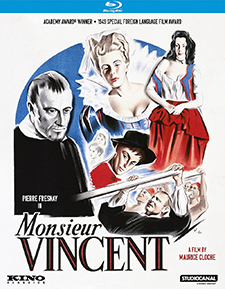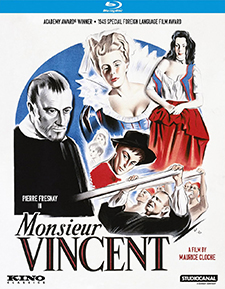Monsieur Vincent (Blu-ray Review)

Director
Maurice ClocheRelease Date(s)
1947 (October 8, 2024)Studio(s)
L’Alliance Générale de Distribution Cinématographique (Kino Classics)- Film/Program Grade: A-
- Video Grade: A-
- Audio Grade: A-
- Extras Grade: B-
Review
The title of the French film Monsieur Vincent (1947) refers to Saint Vincent de Paul (1581-1660), the Occitan French Catholic priest who dedicated his life to serving the poor. Director Maurice Cloche’s film hardly requires a long review—it’s nothing more or less than a straightforward religious-historical biography, stately and well-crafted, featuring a superb performance by Pierre Fresnay (Grand Illusion) in the title role. It’s also something like a nearly two-hour sermon, raising, sometimes cleverly, issues of charity and moral servitude that are still very relevant. The film is too well made to come off as preachy but it also can’t help be that in part.
The picture was very well received throughout Europe as well as in the United States, becoming only the second film awarded a special Academy Award as the year’s Best Foreign Film, the prize not yet competitive. In 1995 the Vatican included it as one of 15 films in its “Religious” category of “important films,” joining the likes of Andrei Rublev, The Passion of Joan of Arc and others.
The film opens with Vincent de Paul arriving in a provincial town only to discover the church in ruins and the populace in lockdown, they are waiting for an old woman to die that they believe has the Black Death. The priest is stoned for his trouble, and when he visits the town’s elite, he finds them holed up much like Prince Prospero in The Masque of the Red Death. To their surprise, Vincent insists on visiting the woman, whom he finds dead of natural causes, not the plague, along with an orphaned girl. He takes her back to the church ruins and sets about rebuilding.
Vincent quickly impresses everyone, rich and poor alike, by his dedication to serving the poor, leading by example. The film’s central theme revolve around this idea, with the priest disposing of all his worldly possessions and though he works tirelessly never feels he’s doing enough. The income inequality of early 17th century France provides him with plenty of poor to look after.
The film eschews religious movie clichés, making the poor sometimes an unruly mob while the idle rich, though hedonistic and often thoughtless, even frivolous much of the time, generally aren’t “let them eat cake” types. They, unlike those in poverty, are a varied lot, some inspired by the advocate priest to knuckle under and actually assist him in appalling conditions. Some of the wealthy women take on helping the poor as a kind of diversion from their dull lives. In one amusing scene, a group of women excitedly discuss designing uniforms for their charity work as if creating some sort of new fashion trend. This is followed by Marguerite Naseau (Geneviève Morel), “the first daughter of charity” humbly asking Vincent de Paul if she might be allowed to perform the dirtiest of tasks (cleaning vomit, etc.) the upper-class women find too unappealing.
The picture is stately, at times approaching epic-film level. The costumes and sets are most elaborate, including a side plot that has Vincent aboard a galley ship, with dozens of rowing slaves.
The picture’s sermonizing might have been a bit much if not for the mesmerizing performance of Pierre Fresnay, who like Robert Donat’s teacher in Goodbye, Mr. Chips believably ages from middle- to old-age with good makeup throughout. Fresney’s interpretation is to play Vincent de Paul as brutally frank but not as a firebrand and definitely earthbound and human. He was, reportedly, the all-time favorite actor of Alec Guinness, and one can see Fresnay’s mannerisms in some of Guinness’s later performances, even his Obi-Wan Kenobi in Star Wars.
The film is rife with historical and religious figures that non-France audiences, for the most part, won’t be familiar with: Philippe-Emmanuel de Gondi, Queen Anne of Austria, Louise de Marillac, etc. At least I spotted Cardinal Richelieu.
Licensed from StudioCanal, Kino’s Blu-ray of Monsieur Vincent presents the black-and-white, 1.37:1 standard format film (not 1.33:1, as listed on the packaging) in a fine, Region “A” encoded transfer. For a late-‘40s French title, the film is in very good shape, though it does exhibit signs of wear here and there. The DTS-HD Master Audio (2.0 mono) is also good, as are the optional English subtitles.
The lone extra is an audio commentary track by film historian Samm Deighan.
Not really great French cinema in the usual sense, Monsieur Vincent is, nevertheless, impressive in its way and recommended.
- Stuart Galbraith IV

